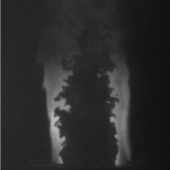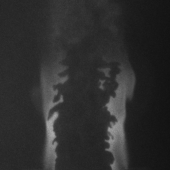Experimental setup Optical diagnostics
The system consists of a pumping laser and a (TDL) coloring laser. The first is a solid-state laser using as medium Nd: YAG (Neodymium: Yttrium - Aluminum – Garnet) working at a frequency of 10 Hz and at an energy of 410 mJ. The second is a laser using as active medium an organic liquid state dye, allowing it to work in a very wide range of wavelengths.
The generated beam by this pumping laser enters the TDL through a set of lenses. In this the wavelength is amplified until obtaining the frequency and energy conditions desired depending on the application.
The laser´s main use is the assessment of gaseous fuels based combustion systems. In the illustration above is shown the setting of the laser to measure the radical OH´s profile in the central plane of a turbulent propane flame in an air induction burner, by the planar laser induced fluorescence technique (PLIF). For this technique the planar laser crosses the flame, projecting itself on the wall as a line (figure 1). The OH radicals present in the flame and intercepted by said plane excite when absorbing the laser´s energy, which reemit. The latter is captured by an ICCD camera instrumented with an optical filter, allowing securing images as that in figure 2. In this figure is shown the intensity distribution concerning the presence of the OH radical, exposing the zone where the combustion process´s chemical reactions take place.
This type of results allows developing numerous studies of phenomenological type in addition to making diagnostics of combustion systems.



